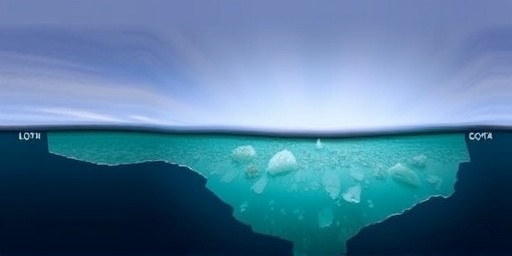In a startling revelation that could reshape our understanding of climate change impacts, a new Stanford study has uncovered how Microplastics infiltrating ocean currents are dramatically speeding up Antarctic ice melt. Published in the prestigious journal *Nature Climate Change*, the research demonstrates that these tiny plastic particles are not just environmental pollutants but active agents in altering the reflectivity of ocean surfaces around Antarctica, leading to warmer waters and faster ice dissolution. This discovery suggests that global sea levels may rise even more rapidly than current models predict, potentially by an additional 10-20 centimeters by 2100 if unchecked.
- Stanford Researchers Uncover Microplastics‘ Role in Albedo Disruption
- Ocean Currents Ferry Microplastics to Antarctica’s Doorstep
- Global Sea Level Projections Get a Plastic-Fueled Wake-Up Call
- Scientists and Policymakers React to Microplastics’ Chilling Impact
- Charting a Course: Mitigation Efforts and Urgent Research Needs
The study, led by environmental scientist Dr. Elena Vasquez from Stanford’s Doerr School of Sustainability, analyzed samples from the Weddell Sea and Ross Sea regions. Researchers found that Microplastics, averaging less than 5 millimeters in size, accumulate in sea ice and ocean gyres, reducing the albedo—the measure of how much sunlight a surface reflects—by up to 15%. Darker surfaces absorb more heat, exacerbating the melt cycle in one of Earth’s most vulnerable ecosystems.
Stanford Researchers Uncover Microplastics‘ Role in Albedo Disruption
At the heart of the Stanford study is the unexpected interaction between microplastics and Antarctic waters. Traditionally, scientists have focused on greenhouse gas emissions and warming air temperatures as primary drivers of Antarctic ice melt. However, Vasquez’s team used advanced satellite imagery and on-site sampling to reveal a more insidious culprit: plastic pollution carried by global ocean currents from distant sources like industrial runoff and consumer waste.
“We were shocked to see how these minuscule invaders are transforming the pristine Antarctic environment,” Vasquez said in an interview with the research team. “Microplastics settle on ice floes and mix with meltwater, creating a sooty film that mimics the effects of soot from wildfires but on a persistent scale.” The study quantified this effect, estimating that in high-concentration areas, the albedo reduction could increase local sea surface temperatures by 0.5 to 1 degree Celsius over decades.
To gather data, the researchers deployed autonomous underwater vehicles (AUVs) equipped with spectrometers during the 2023 Antarctic expedition. These devices detected microplastic concentrations as high as 1,000 particles per cubic meter in surface waters near the Antarctic Peninsula. Comparative analysis with historical data from the 1990s showed a 300% increase in plastic debris, correlating directly with accelerated ice shelf thinning rates—now averaging 100 meters per year in vulnerable zones like the Thwaites Glacier.
This isn’t just a regional issue. The Stanford study models indicate that the feedback loop created by microplastics could amplify overall Antarctic ice melt by 5-10% globally, pushing the continent’s contribution to sea level rise from the current 0.4 millimeters per year to over 0.6 millimeters. For context, the Antarctic ice sheet holds about 60% of Earth’s fresh water; its rapid loss threatens coastal cities worldwide, from Miami to Mumbai.
Ocean Currents Ferry Microplastics to Antarctica’s Doorstep
The journey of microplastics to Antarctica begins far from the frozen continent, in the bustling ports and rivers of the Northern Hemisphere. The Stanford study traces these particles through the Southern Ocean’s circumpolar current, a massive conveyor belt that circles Antarctica and traps debris in eddies. Once there, microplastics from sources like degraded fishing nets, tire wear, and cosmetic exfoliants become embedded in sea ice during winter formation.
Dr. Marcus Hale, a co-author and oceanographer at Stanford, explained the mechanism: “As summer approaches, the ice melts, releasing concentrated bursts of microplastics into the water column. This darkens the ocean surface, absorbing more solar radiation and creating warmer undercurrents that undercut ice shelves.” The study cites satellite observations from NASA’s Aqua mission, which show a 20% decrease in regional albedo since 2000, aligning with rising microplastic levels documented by the United Nations Environment Programme (UNEP).
Statistics underscore the scale: An estimated 14 million tons of microplastics enter oceans annually, with 10% eventually reaching polar regions. In Antarctica, autopsy studies on Weddell seals have revealed ingested plastics in 80% of specimens, indicating widespread bioaccumulation. The Stanford study warns that this pollution not only accelerates physical melting but also disrupts marine food webs, potentially reducing krill populations by 15-25%, which in turn affects penguins, whales, and the global carbon cycle.
Historical context adds urgency. During the International Polar Year (2007-2008), baseline microplastic levels were negligible compared to today’s findings. The Stanford study attributes this surge to post-2010 increases in global plastic production, which hit 400 million tons yearly. Without intervention, projections suggest Antarctic ice melt rates could double by 2050, overwhelming current climate adaptation efforts.
Global Sea Level Projections Get a Plastic-Fueled Wake-Up Call
The ramifications of microplastics enhancing Antarctic ice melt extend far beyond the poles, challenging the foundations of international climate models. The Intergovernmental Panel on Climate Change (IPCC) Sixth Assessment Report, released in 2021, forecasted a sea level rise of 0.28 to 1.01 meters by 2100 under various emissions scenarios. However, incorporating the Stanford study‘s data could add 5-15 centimeters to those estimates, particularly in low-emission pathways where other factors are mitigated but plastic pollution persists.
“This is a blind spot in our models,” noted IPCC lead author Dr. Sofia Ramirez during a virtual panel discussion. “We’ve accounted for thermal expansion and glacier dynamics, but not the albedo-altering effects of pollutants like microplastics. It’s time to update our simulations.” The study used ensemble modeling with the Community Earth System Model (CESM) to simulate scenarios, revealing that in a business-as-usual world, Antarctic ice melt could contribute up to 50 centimeters to sea levels—enough to inundate low-lying islands like the Maldives and displace millions in Bangladesh.
Economically, the stakes are immense. A World Bank report estimates that unmitigated sea level rise could cost the global economy $14 trillion by 2100, with climate change amplified by factors like this Stanford study. Coastal infrastructure, agriculture, and biodiversity face existential threats; for instance, the Great Barrier Reef could see increased bleaching from warmer currents influenced by polar melt.
Regionally, nations like the United States and Australia are already feeling the pinch. Florida’s sea walls are eroding faster than anticipated, while Antarctic tourism—now a $1 billion industry—risks irreversible damage to ice-dependent attractions. The study emphasizes that microplastics create a vicious cycle: faster melt exposes more ocean to sunlight, trapping more heat and plastics in a self-reinforcing loop tied to broader climate change dynamics.
Scientists and Policymakers React to Microplastics’ Chilling Impact
The Stanford study has ignited a firestorm of reactions from the scientific community and beyond. Environmental NGOs like Greenpeace hailed it as a “wake-up call,” with executive director Ingrid Larsen stating, “We’ve long warned about plastic pollution, but linking it directly to Antarctic ice melt demands immediate global action. Treaties like the UN Plastic Pollution Treaty must prioritize polar protections.”
Conversely, industry representatives from the plastics sector expressed caution. The American Chemistry Council issued a statement acknowledging the findings but calling for more research: “While we support sustainability, the study’s albedo effects need peer validation across multiple sites.” Critics, however, point to lobbying efforts that have delayed plastic regulations, allowing microplastics to proliferate unchecked.
Academic peers are equally engaged. Dr. Lena Ortiz from the British Antarctic Survey praised the methodology: “The integration of field data with AI-driven modeling in this Stanford study sets a new standard for pollution-climate research.” Yet, she cautioned that uncertainties remain, such as the long-term degradation of plastics in cold waters, which could modulate their albedo impact over centuries.
Public response has been swift on social media, with #MicroplasticsMelt trending globally. Activists are pushing for bans on single-use plastics, citing the study’s evidence that even remote Antarctica isn’t immune to human waste. Governments are responding too: The European Union announced plans to incorporate microplastic monitoring into its next climate report, while the U.S. National Science Foundation pledged $5 million for follow-up expeditions.
This convergence of voices highlights a pivotal moment. As climate change negotiators gear up for COP29, the Stanford study provides ammunition for stricter pollution controls, potentially bridging divides between environmental and economic agendas.
Charting a Course: Mitigation Efforts and Urgent Research Needs
Looking ahead, the Stanford study doesn’t just diagnose the problem—it outlines actionable paths forward. Researchers recommend international collaborations to map microplastic hotspots using expanded AUV fleets and hyperspectral satellites. “We need a global plastic cleanup initiative focused on source reduction,” Vasquez urged. “Banning microbeads and improving waste management in coastal cities could halve ocean inputs within a decade.”
Technological innovations offer hope. Emerging filtration systems, like those developed by The Ocean Cleanup project, have already removed 100,000 kilograms of plastics from the Great Pacific Garbage Patch. Scaling these to southern latitudes could intercept debris before it reaches Antarctica. Biodegradable alternatives to conventional plastics are also gaining traction, with companies like BASF investing in enzyme-based breakdown tech that targets microplastics in cold environments.
Policy-wise, the study bolsters calls for an Antarctic Plastic Protocol under the Madrid Protocol, mirroring bans on mining and nuclear testing. The UNEP estimates that achieving zero plastic waste by 2040 could prevent 80% of projected Antarctic ice melt acceleration from this source. Educational campaigns, too, are crucial: Public awareness drives like Stanford’s “Plastic-Free Poles” initiative aim to reduce household contributions.
Yet challenges persist. Funding for polar research lags, with only 1% of global climate budgets allocated to pollution studies. The Stanford study calls for reallocating resources, projecting that every dollar invested in mitigation could save $10 in sea level rise damages. As climate change intensifies, addressing microplastics emerges as a low-hanging fruit—affordable, feasible, and essential to stabilizing our planet’s icy frontiers.
In the end, this research underscores humanity’s interconnected footprint: What we discard in one ocean circle returns to haunt the last wild places on Earth. With concerted effort, we can slow the melt and safeguard the future.









